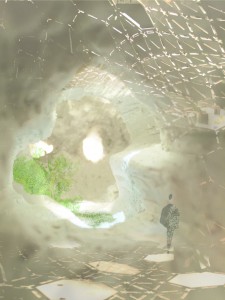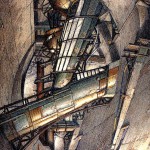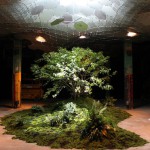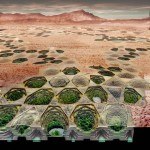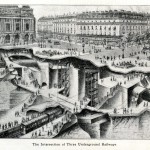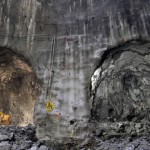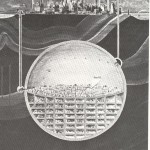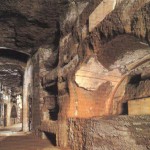SUBTERRANEAN INTERIORITY
|
Conforming to the historical anthropological desire and imagination of underground urbanism, this thesis will explore the possibility of subterranean architecture anticipating the interiority and mediation between subterranean space and the nature in aspiration of a design to push inhabitability of subterranean space to its threshold. HOW? Phase 1: Site research and analysis The thesis research will require a comprehensive understanding of the existing subterranean architecture of the existing site and the limitation of underground construction to identify the possible development of the existing earth. A specific site will be selected as the testing ground for the urban prototype. Analytical mapping and modelling of the site condition in the invisible city and also the surface city will be produced. Phase 2: Case study and preliminary design Precedent of underground projects will be studied as a technical reference to understand the design possibility in relation to the different natural medium including earth, sunlight, water etc. As a preliminary stage of design a fundamental spacial organization will be developed through series of systematic massing study informed by subtraction action of earth base on physical model construction. The hierarchical and preliminary design of massing will be anticipated with a scale of 1:1000 to 1:500. Phase 3: Design development and consolidation As a subsequent stage the design of an adaptive structure mediating the nature and the space of the subterranean architecture will be developed. The intermediate spaces will be commenced with an introduction of a programmatic design. Detailed structural design will be visualized with the production of deliverables including plans and sections of scale 1:200 and physical models. Phase 4: Refinement of the design and final proposal production The final proposal and the detailed design will be modified based on the comments and possible development of the design detail maybe performed. Final deliverables including a master plan in scale 1:1000 and zoom-in design in scale of 1:500 and 1:200 will be produced for a efficient elaboration of the subterranean urban proposal. WHAT? The project will be located in a subway construction site in Hong Kong as a testing ground for subterranean architectural proposal for metropolis with complex urban context and underground infrastructure. The existing construction site for the West Kowloon High Speed Railway Station or an construction site for a MTR station in Hong Kong would be possible site for the test case. With the intention to explore the mediation between the nature and subterranean space, the site chosen would be a semi open site with underground spaces being constructed. Given that the existing underground urban developments of the existing site is merely interiorized and autonomous, the thesis would seek for a three-dimensional proposal within the subterranean realm with response to the nature of the surrounding. An interiorized spacial organisation would be fundamental with a design of a mechanical system evoking engagement with the nature. The architectural design would mediate between the human activity with the underground environment in relation to different medium in the nature. WHY? There has been a long history of human’s imagination and design attempt regarding subterranean architecture and urbanism. Yet many of the successful precedents of constructed underground spaces falls into the field of uninhabitable and totally interiorized space, tombs and religious chambers mostly. The existing perception and design in the discipline of underground spaces are remained merely totally autonomous and interiorize space. There is a lack of design in line with the advancement of technology engaging and celebrating the nature of subterranean spaces. Subway stations and basement apartment stores are best exemplifications of the existing interiorized architecture underground. There are some test cases dealing with existing underground space and they are solely reprograming or restoration of existing abandoned subterranean spaces like bomb shelters and missile silo.Apart from the historical fictional underground city proposals, there are several precedents of contemporary architectural proposal looking at subterranean architecture. The Sietch Nevada project proposes the construction of communal spaces between the water infrastructure underground in an extreme condition of a desert. The other examples is the commenced project Lowline which will be operating in 2018. With the advancement in solar technology, the project visions in creating the world’s first underground public space with greenery and natural lighting. The thesis will be exploring the possibility of design of inhabitable architectural space within the realm of the interiority with close reference to the mediation of surface quality like light and air, in pursuit of an urban proposal for the overlooked underground space. BIBLIOGRAPHY: Theoretical reference: 1. Kisho Kurokawa, 1994, The Philosophy of Symbiosis, Academy Editions 2. Lewis Mumford, 1961, The City in History, Penguin Books 3. Peter Eisenman, 1999, Diagram diaries, New York: Universe 4. James Turrell, 1999, James Turrell eclipse, Michael Hue-Williams Fine Art in association with Hatje Cantz Publishers 5. Reyner Banham, 1969, The Architecture of the Well-tempered Environment, Achitectural Press 6. Reyner Banham, 1971, The Architecture of Four Ecologies, Harmondsworth 7. Rosalind Williams, 1990, Notes on the Underground, MIT Press Technique reference: 1. Peter Cook, 1973, Archigram, Praeger Publishers 2. David Macaulay, 1976, Underground, Houghton Mifflin 3. Lebbeus Woods, 2011, OneFiveFour, Princeton Architectural Press 4. Mas Yendo, 2001, Ironic Diversion, Springer Wien New York Seminal/current project reference: 1. James Ramsey,“Lowline”, Manhattan, New York, 2018 2. Matsys, “Sietch Nevada”, Exhibition at the University of Toronta, 2009 3. BNKR Arquitectura, “Earthscraper”, Mexico City, 2011 4. Dane Bunton, “The Post-terranean Mega Subtropolis”, California College of the Arts, 2013 |
